Eftychios Protopapadakis
Outlier detection in maritime environments using AIS data and deep recurrent architectures
Jun 14, 2024Abstract:A methodology based on deep recurrent models for maritime surveillance, over publicly available Automatic Identification System (AIS) data, is presented in this paper. The setup employs a deep Recurrent Neural Network (RNN)-based model, for encoding and reconstructing the observed ships' motion patterns. Our approach is based on a thresholding mechanism, over the calculated errors between observed and reconstructed motion patterns of maritime vessels. Specifically, a deep-learning framework, i.e. an encoder-decoder architecture, is trained using the observed motion patterns, enabling the models to learn and predict the expected trajectory, which will be compared to the effective ones. Our models, particularly the bidirectional GRU with recurrent dropouts, showcased superior performance in capturing the temporal dynamics of maritime data, illustrating the potential of deep learning to enhance maritime surveillance capabilities. Our work lays a solid foundation for future research in this domain, highlighting a path toward improved maritime safety through the innovative application of technology.
Enhancing Deep Learning Model Explainability in Brain Tumor Datasets using Post-Heuristic Approaches
Apr 30, 2024Abstract:The application of deep learning models in medical diagnosis has showcased considerable efficacy in recent years. Nevertheless, a notable limitation involves the inherent lack of explainability during decision-making processes. This study addresses such a constraint, by enhancing the interpretability robustness. The primary focus is directed towards refining the explanations generated by the LIME Library and LIME image explainer. This is achieved throuhg post-processing mechanisms, based on scenario-specific rules. Multiple experiments have been conducted using publicly accessible datasets related to brain tumor detection. Our proposed post-heuristic approach demonstrates significant advancements, yielding more robust and concrete results, in the context of medical diagnosis.
Multi-scale Intervention Planning based on Generative Design
Apr 23, 2024Abstract:The scarcity of green spaces, in urban environments, consists a critical challenge. There are multiple adverse effects, impacting the health and well-being of the citizens. Small scale interventions, e.g. pocket parks, is a viable solution, but comes with multiple constraints, involving the design and implementation over a specific area. In this study, we harness the capabilities of generative AI for multi-scale intervention planning, focusing on nature based solutions. By leveraging image-to-image and image inpainting algorithms, we propose a methodology to address the green space deficit in urban areas. Focusing on two alleys in Thessaloniki, where greenery is lacking, we demonstrate the efficacy of our approach in visualizing NBS interventions. Our findings underscore the transformative potential of emerging technologies in shaping the future of urban intervention planning processes.
A Few-Shot Attention Recurrent Residual U-Net for Crack Segmentation
Mar 02, 2023Abstract:Recent studies indicate that deep learning plays a crucial role in the automated visual inspection of road infrastructures. However, current learning schemes are static, implying no dynamic adaptation to users' feedback. To address this drawback, we present a few-shot learning paradigm for the automated segmentation of road cracks, which is based on a U-Net architecture with recurrent residual and attention modules (R2AU-Net). The retraining strategy dynamically fine-tunes the weights of the U-Net as a few new rectified samples are being fed into the classifier. Extensive experiments show that the proposed few-shot R2AU-Net framework outperforms other state-of-the-art networks in terms of Dice and IoU metrics, on a new dataset, named CrackMap, which is made publicly available at https://github.com/ikatsamenis/CrackMap.
Diabetic foot ulcers monitoring by employing super resolution and noise reduction deep learning techniques
Sep 20, 2022
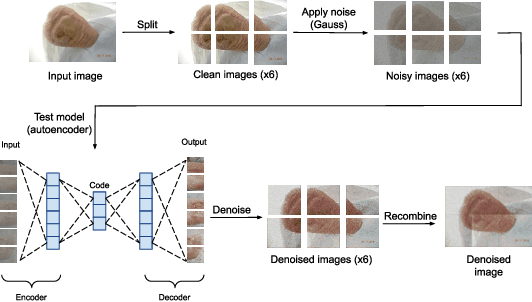


Abstract:Diabetic foot ulcers (DFUs) constitute a serious complication for people with diabetes. The care of DFU patients can be substantially improved through self-management, in order to achieve early-diagnosis, ulcer prevention, and complications management in existing ulcers. In this paper, we investigate two categories of image-to-image translation techniques (ItITT), which will support decision making and monitoring of diabetic foot ulcers: noise reduction and super-resolution. In the former case, we investigated the capabilities on noise removal, for convolutional neural network stacked-autoencoders (CNN-SAE). CNN-SAE was tested on RGB images, induced with Gaussian noise. The latter scenario involves the deployment of four deep learning super-resolution models. The performance of all models, for both scenarios, was evaluated in terms of execution time and perceived quality. Results indicate that applied techniques consist a viable and easy to implement alternative that should be used by any system designed for DFU monitoring.
Towards trustworthy Energy Disaggregation: A review of challenges, methods and perspectives for Non-Intrusive Load Monitoring
Jul 05, 2022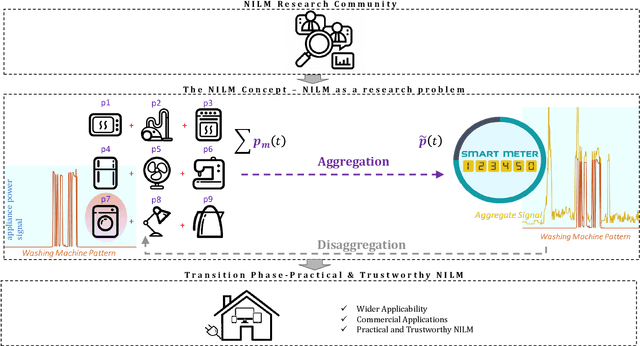
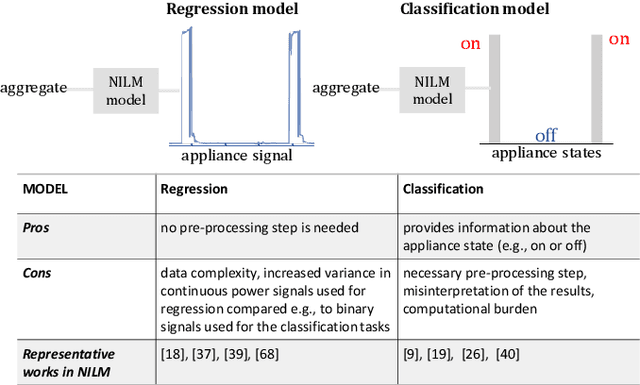
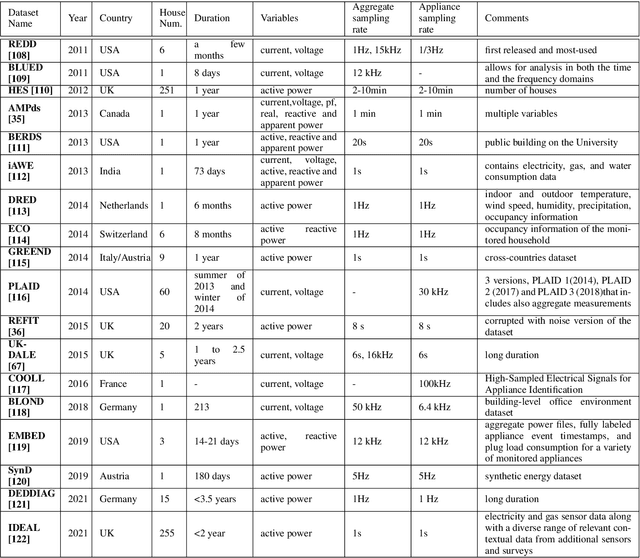
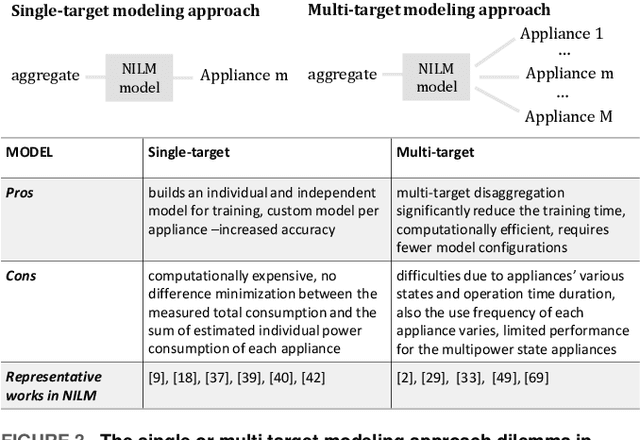
Abstract:Non-intrusive load monitoring (NILM) is the task of disaggregating the total power consumption into its individual sub-components. Over the years, signal processing and machine learning algorithms have been combined to achieve this. A lot of publications and extensive research works are performed on energy disaggregation or NILM for the state-of-the-art methods to reach on the desirable performance. The initial interest of the scientific community to formulate and describe mathematically the NILM problem using machine learning tools has now shifted into a more practical NILM. Nowadays, we are in the mature NILM period where there is an attempt for NILM to be applied in real-life application scenarios. Thus, complexity of the algorithms, transferability, reliability, practicality and in general trustworthiness are the main issues of interest. This review narrows the gap between the early immature NILM era and the mature one. In particular, the paper provides a comprehensive literature review of the NILM methods for residential appliances only. The paper analyzes, summarizes and presents the outcomes of a large number of recently published scholarly articles. Also, the paper discusses the highlights of these methods and introduces the research dilemmas that should be taken into consideration by researchers to apply NILM methods. Finally, we show the need for transferring the traditional disaggregation models into a practical and trustworthy framework.
TraCon: A novel dataset for real-time traffic cones detection using deep learning
May 24, 2022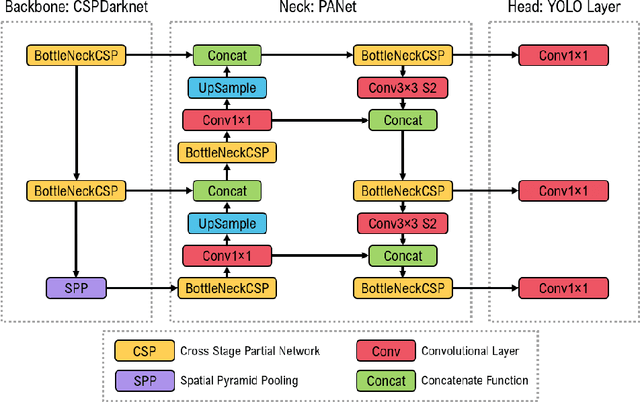

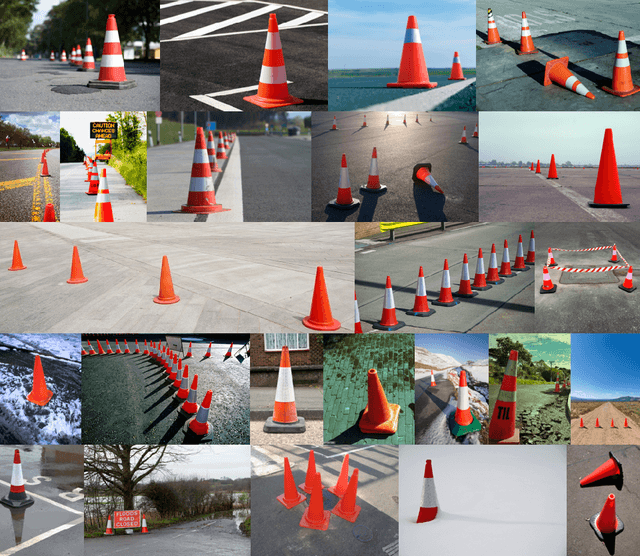
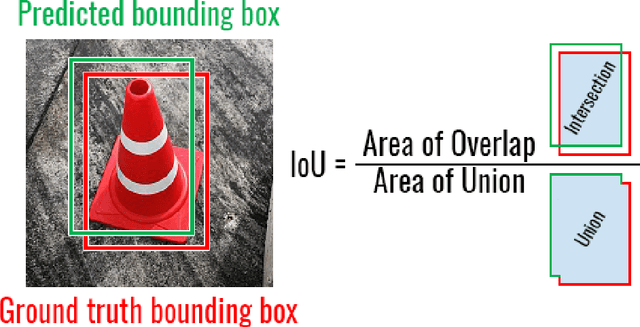
Abstract:Substantial progress has been made in the field of object detection in road scenes. However, it is mainly focused on vehicles and pedestrians. To this end, we investigate traffic cone detection, an object category crucial for road effects and maintenance. In this work, the YOLOv5 algorithm is employed, in order to find a solution for the efficient and fast detection of traffic cones. The YOLOv5 can achieve a high detection accuracy with the score of IoU up to 91.31%. The proposed method is been applied to an RGB roadwork image dataset, collected from various sources.
Evaluating Transferability for Covid 3D Localization Using CT SARS-CoV-2 segmentation models
May 19, 2022



Abstract:Recent studies indicate that detecting radiographic patterns on CT scans can yield high sensitivity and specificity for Covid-19 localization. In this paper, we investigate the appropriateness of deep learning models transferability, for semantic segmentation of pneumonia-infected areas in CT images. Transfer learning allows for the fast initialization/reutilization of detection models, given that large volumes of training data are not available. Our work explores the efficacy of using pre-trained U-Net architectures, on a specific CT data set, for identifying Covid-19 side-effects over images from different datasets. Experimental results indicate improvement in the segmentation accuracy of identifying Covid-19 infected regions.
Robotic Maintenance of Road Infrastructures: The HERON Project
May 09, 2022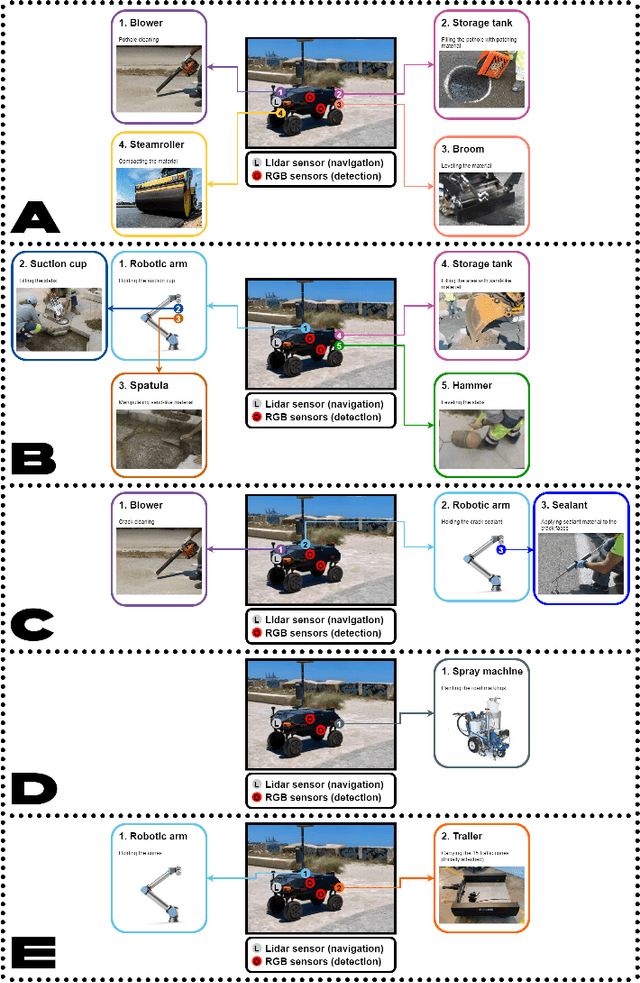

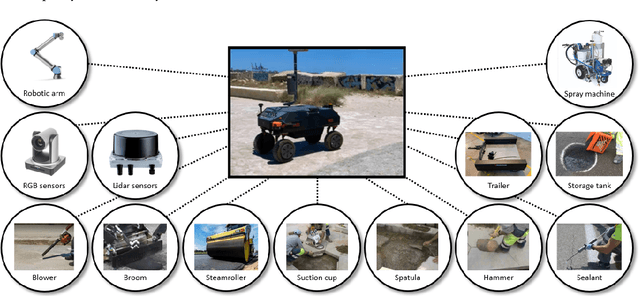
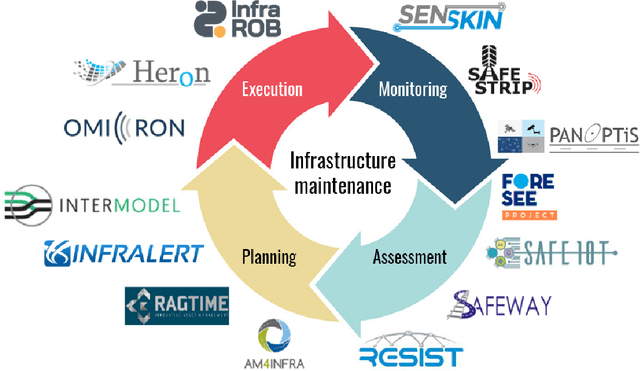
Abstract:Of all public assets, road infrastructure tops the list. Roads are crucial for economic development and growth, providing access to education, health, and employment. The maintenance, repair, and upgrade of roads are therefore vital to road users' health and safety as well as to a well-functioning and prosperous modern economy. The EU-funded HERON project will develop an integrated automated system to adequately maintain road infrastructure. In turn, this will reduce accidents, lower maintenance costs, and increase road network capacity and efficiency. To coordinate maintenance works, the project will design an autonomous ground robotic vehicle that will be supported by autonomous drones. Sensors and scanners for 3D mapping will be used in addition to artificial intelligence toolkits to help coordinate road maintenance and upgrade workflows.
Evaluating the Usefulness of Unsupervised monitoring in Cultural Heritage Monuments
Jul 02, 2021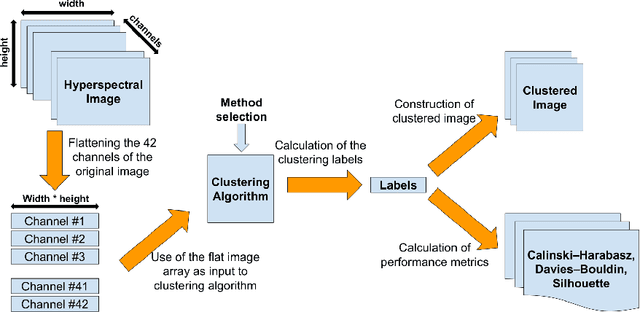

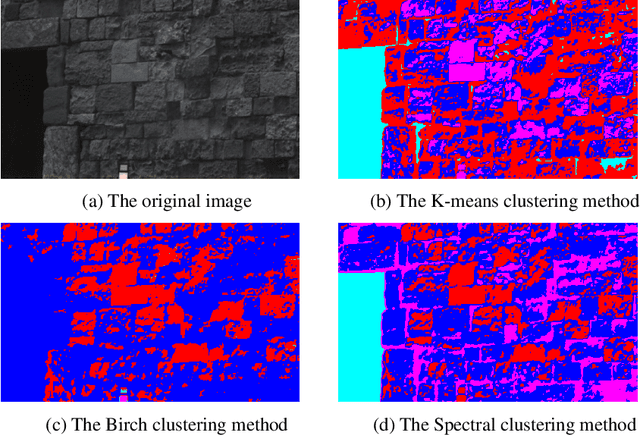
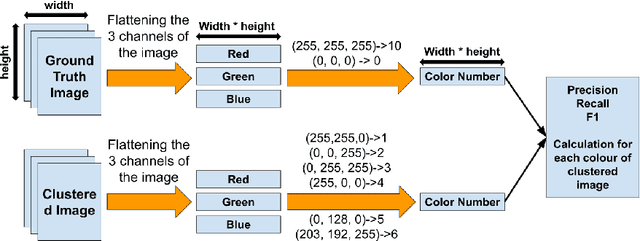
Abstract:In this paper, we scrutinize the effectiveness of various clustering techniques, investigating their applicability in Cultural Heritage monitoring applications. In the context of this paper, we detect the level of decomposition and corrosion on the walls of Saint Nicholas fort in Rhodes utilizing hyperspectral images. A total of 6 different clustering approaches have been evaluated over a set of 14 different orthorectified hyperspectral images. Experimental setup in this study involves K-means, Spectral, Meanshift, DBSCAN, Birch and Optics algorithms. For each of these techniques we evaluate its performance by the use of performance metrics such as Calinski-Harabasz, Davies-Bouldin indexes and Silhouette value. In this approach, we evaluate the outcomes of the clustering methods by comparing them with a set of annotated images which denotes the ground truth regarding the decomposition and/or corrosion area of the original images. The results depict that a few clustering techniques applied on the given dataset succeeded decent accuracy, precision, recall and f1 scores. Eventually, it was observed that the deterioration was detected quite accurately.
 Add to Chrome
Add to Chrome Add to Firefox
Add to Firefox Add to Edge
Add to Edge